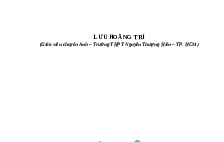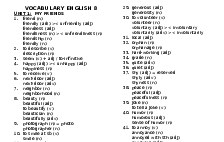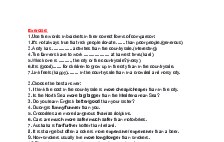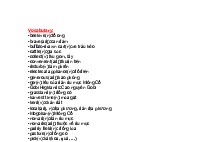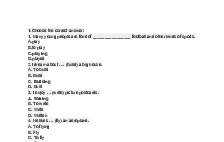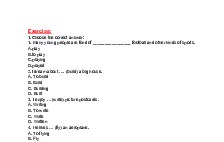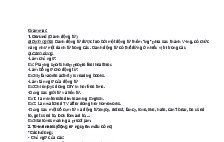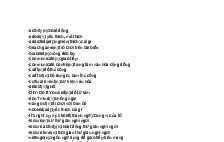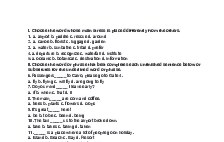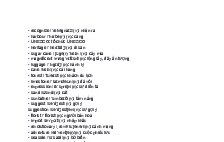Đề thi Olympic Tiếng Anh lớp 8 trường THCS Nguyễn Trãi - Thái Bình
Nội dung tài liệu
Tải xuống
Link tài liệu:
Các tài liệu liên quan
Có thể bạn quan tâm
Thông tin tài liệu
SỞ GD-ĐT THÁI BÌNH
TRƯỜNG THPT NGUYỄN TRÃI
ĐỀ THI OLYMPIC NĂM HỌC 2017 - 2018
MÔN: TIẾNG ANH
Thời gian làm bài: 90 phút (không kể thời gian giao đề)
SECTION A: 8 points
Read the following passage and mark the letter A, B, C, or D on your answer sheet to indicate the correct
answer to each of the questions from
A pilot cannot fly by sight alone. In many conditions, such as flying at night and landing in dense
fog, a pilot must use radar, an alternative way of navigating. Since human eyes are not very good at
determining speeds of approaching objects, radar can show a pilot how fast nearby planes are moving. The
basic principle of radar is exemplified by what happens when one shouts in a cave. The echo of the sounds
against the walls helps a person determine the size of the cave. With radar, however, the waves are radio
waves instead of sound waves. Radio waves travel at the speed of light, about 300,000 kilometres in one
second. A radar set sends out a short burst of radio waves. Then it receives the echoes produced when the
waves bounce off objects. By determining the tune it takes for the echoes to return to the radar set, a trained
technician can determine the distance between the radar set and other objects. The word “radar” in fact gets
its name from the term “radio detection and ranging”. “Ranging” is the term for detection of the distance
between an object and the radar set. Besides being of critical importance to pilots radar is essential for air
traffic control tracking ships at sea, and for tracking weather systems and storms.
Question 1: What is the mam topic of this passage?
A. Alternatives to radar B. The nature of radar C. History of radar D. Types of ranging
Question 2: According to the passage, what can radar detect besides location of objects?
A. shape
B. size
C. speed
D. weight
Question 3: The word “exemplified" in the passage can be replaced by ______.
A. “illustrated’ B. “specified”
C. “resembled”
D. “justified”
Question 4: The word "shouts” in the passage most closely means ______.
A. “shoots”
B. ‘"whispers”
C. “exclaims”
D". “yells”
Question 5: Which of the following words best describes the tone of this passage?
A. humorous
B. argumentative
C. explanatory D. imaginative
Question 6: According to the passage, the distance between a radar set and an object can be determined
by______.
A. the term “ranging" used for detection of the distance between an object and the radar set
B. the time it takes for the radio waves to produce echoes and bounce off the object
C. the tune it takes for a burst of radio waves to produce echoes when the waves bounce off the
object
D. the time it takes for the echoes produced by the radio waves to return to the radar set
Question 7: Which type of waves does radar use?
A. radio
B. sound
C. tidal
D. heat
Question 8: The word “tracking” in the passage most closely means______.
A. sending
B. ranging
C. repairing
D. searching for
Question 9: Which of the following would most likely be the topic of the next paragraph?
A. A history of flying.
B. Other uses of radar.
C. The technology used by pilots.
D. Uses of some technology.
Question 10: What might be inferred about radar?
A. It was developed from a study of sound waves. C. It gave birth to the invention of the airplane.
B. It takes the place of a radio.
D. It has improved navigational safety.
Mark the letter A, B, C, or D on your answer sheet to show the underlined part that needs correction.
Question 11: The rate of snow accumulation in the formation area are critical to the pace of glacial
movement.
A. to the
B. movement
C. are
D. accumulation
Question 12: More murders are reported in December in the United States than for any other month.
A. are reported
B. for
C. More
D. the
Question 13: Although Emily Dickinson publishes only three of her verses before she died, today there are
more than one thousand of her poems printed in many important collections.
A. publishes
B. there are
C. in
D. thousand of
Question 14: Humans who lived thousands years ago, long before alphabets were devised, they used
pictures to record events and to communicate ideas.
A. ago
B. who
C. they
D. to communicate
Question 15: More companies returned to the task of development new kinds of antibiotics, and as this
book is being prepared, a number are undergoing clinical trials.
A. development B. a
C. to
D. kinds of
Mark the letter A, B, C, or D on your answer sheet to indicate the word(s) CLOSEST in meaning to the
underlined word(s) in each of the following questions
Question 16: The girl’s distant and haughty behavior made people forget just how talented she was.
A. kind
B. genuine
C. arrogant
D. elegant
Question 17: Paul always gets nervous whenever he has to give a presentation.
A. anxious
B. fearful
C. impressed
D. supportive
Question 18: Many families struggle to make ends meet in this difficult
situation.
A. earn just enough money to be able to buy the things you need
B. earn more money to be able to buy the things you need
C. ask others for some money
D. give money to others
Mark the letter A, B, C, or D on your answer sheet to indicate the word whose underlined part is
pronounced differently from that of the rest in each of the following questions
Question 19: A. blanket
B. many
B. creature
C. matter
D. fanpage
Question 20: A. create
C. creative
D. creation
Mark the letter A, B, C, or D on your answer sheet to indicate the correct answer to each of the
following questions.
Question 21: Some students don’t know how to do the exercise ______ by the teacher yesterday.
A. is giving
B. who given
C. which given
D. given
Question 22: Finally we found a flat which is rather small but it ______ our needs perfectly.
A. supplies
B. settles
C. meets
D. fills
Question 23: All of us should be aware of that internet is very useful for us but it also has lots of
disadvantages so while ______the web be alert!
A. surf
B. surfed
C. surfing
D. to surf
Question 24: The teacher made up a difficult question, but at last, Tom came ______ a good answer.
A. up for
B. up with
C. up to
D. up against
Question 25: ______ disabled children cannot enjoy toys designed for nondisabled youngsters is the subject
of the report.
A. Those
B. Because
C. What
D. That
Question 26: You should have ______ your research paper again before you handed it in.
A. gone over
B. gone down with
C. gone under
D. gone with
Question 27: It is 6.50 am. The guard ______ the school gate in 10 minutes as usual.
A. has closed
B. closes
C. will close
D. will be closing
Question 28: ______ your help, I wouldn’t have passed all the difficulties.
A. According to
B. In stead of
C. Because of
D. But for
Question 29: I must say that you are the only friend ______ all my secrets.
A. shared
B. to share
C. sharing
D. to be shared
Question 30: When we arrived at the meeting place, the others ______.
A. left
B. are leaving
C. have left
D. had left
Question 31: She didn’t come to our wedding, she just made a phone call and said she wished ______.
A. our wedding would be happy
B. a happy wedding
C. us a happy wedding
D. our wedding were happy
Question 32: He is packing his luggage. It seems as if he ______ on business.
A. would go
B. went
C. is going
D. had gone
Question 33: Don’t be late for the class often, ______ people will think you are a disobedient student.
A. otherwise
B. or so
C. unless
D. if not
Question 34: More than one student in my class ______ from Ha Noi.
A. comes
B. have come
C. would have come
D. would come
Question 35: ______ harder he would have passed the exam.
A. Had Mark studied
B. If Mark had not studied
C. were Mark studied
D. If Mark studied
Question 36: By the time you get back this evening, I ______ all my homework and then I can help you
with yours.
A. will be finished
B. have finished
C. will have finished
D. will finish
Mark the letter A, B, C, or D on your answer sheet to indicate the most suitable response to complete each
of the following exchanges.
Question 37: Alice and Carol are at school yard.
Alice: “What shall we do this weekend?” Carol: “______.”
A. I went out for dinner
B. Oh, that’s good
C. No problem
D. Let’s go out for dinner
Question 38: Tom is at the fashion shop.
Tom: “I like the blue jacket, please! Can I try it on?”
Salesgirl: “Yes, ______.”
A. you must
B. you do
C. certainly
D. you would
Question 39: Tony and Mary are at the party.
Tony: “It’s time for me to leave. Goodbye” - Mary: “______.”
A. Nice to meet you
B. So long
C. All right
D. No problem
Read the following passage and mark the letter A, B, C, or D on your answer sheet to indicate the correct
answer to each of the questions from
One of the major problems in the art world is how to distinguish and promote an artist. In effect, a
market must be created for an artist to become successful. The practice of signing and numbering individual
prints was introduced by James Abbott McNeill Whistler, the nineteenth-century artist best known for the
painting of his mother, called “Arrangement in Grey and Black,” but known to most of us as “Whistler’s
Mother.” Whistler’s brother-in-law, Sir Francis Seymour Haden, a less well-known artist, had speculated
that collectors might find prints more attractive if they knew that there were only a limited number of copies
produced. By signing the work in pencil, an artist could guarantee and personalize each print.
As soon as Whistler and Haden began the practice of signing and numbering their prints, their work
began to increase in value. When other artists noticed that the signed prints commanded higher prices, they
began copying the procedure.
Although most prints are signed on the right-hand side in the margin below the image, the placement of
the signature is a matter of personal choice. Indeed, prints have been signed within the image, in any of the
margins, or even on the reverse side of the print. Whenever the artist elects to sign it, a signed print is still
valued above an unsigned one, even in the same edition.
Question 40: Which of the following would be a better title for the passage?
A. Whistler’s Mother
B. Copying Limited Edition Prints
C. The Practice of Signing Prints D. Whistler’s Greatest Works
Question 41: What made Whistler’s work more valuable?
A. His brother-in-law’s prints
B. His signature on the prints
C. His painting of his mother
D. His fame as an artist
Question 42: The word “speculated” could be best replaced by______.
A. denied
B. guessed
C. noticed
D. announced
Question 43: The word “distinguish” is closest in meaning to ______.
A. making improvement
B. accept changes
C. recognize differences
D. allow exceptions
Question 44: The word “it” refers to______.
A. the image
B. the reverse side
C. the same edition
D. a print
Question 45: Where in the passage does the author indicate where an artist’s signature might be found on a
work?
A. Paragraph 1
B. Paragraph 2
C. Paragraph 3 D. all paragraphs
Question 46: What does the author mean by the statement: “As soon as Whistler and Haden began the
practice of signing and numbering their prints, their work began to increase in value.”?
A. The prints that were signed and numbered were worth more.
B. The signatures became more valuable than the prints.
C. The signing and numbering of prints was not very popular.
D. Many copies of the prints were made.
Question 47: What was true about the painting of Whistler’s mother?
A. It was a completely new method of painting.
B. It was not one of Whistler’s best paintings.
C. It was painted by Sir Francis Seymour Haden.
D. Its title was “Arrangement in Grey and Black.”
Question 48: The author mentions all of the following as reasons why a collector prefers a signed print
EXCEPT ______.
A. it guarantees the print’s authenticity
B. it encourages higher prices for the
print
C. it makes the print more personal
D. it limits the number of copies of the print
Question 49: It can be inferred from the passage that artists number their prints _____.
A. at the same place on each of the prints
B. when the buyer requests it
C. as an accounting procedure
D. to guarantee a limited edition
Mark the letter A, B, C, or D on your answer sheet to indicate the word that differs from the rest in
the position of the main stress in each of the following questions.
Question 50: A. pretty
B. marine
C. solemn
D. eager
Question 51: A. entertainment
B. calculation
C. photographic
D. biography
Question 52: A. necessarily
B. literature
C. television
D.
secretary
Read the following passage and mark the letter A, B, C, or D on your answer sheet to indicate the
correct word.
One of the most urgent environmental problems in the world today is the shortage of clean water.
Having clean drinking water is a basic human right. But acid rain, (53) ______ pollution and garbage have
made many sources of water undrinkable. Lakes, reservoirs and even entire seas have become vast pools
(54) ______ poison. Lake Baikal in Russia is one of the largest lakes in the world. It (55) ______ a rich
variety of animals and plants, including 1,300 rare species that do not exist (56) ______ else in the world.
But they are being destroyed by the massive volumes of toxic effluent which (57) ______ into the lake every
day. Even where law existed, the government did not have the power to enforce them.
Most industries simply ignore the regulations. The Mediterranean Sea (58) ______1% of the world's
water surface. But it is the dumping (59) ______for 50% of all marine pollution. Almost 16 countries
regularly throw industrial wastes a few miles (60) ______shore.
Water is free to everyone. A few years ago, people thought that the supply of clean water in the
world was limitless. Today, many water supplies have been (61) ______ by pollution and sewage. Clean
water is now scarce, and we are at last beginning to respect this precious (62) ______.We should do
something now.
(Source: v14ilovetranslation.com)
Question 53: A. industrious B. industry
C. industrial
D. industrialized
Question 54: A. on
B. in
C. of
D. to
Question 55: A. composes B. contains
C. encloses
D. consists
Question 56: A. where
B. somewhere
C. everywhere
D. anywhere
Question 57: A. stay
B. pour
C. boil
D. burn
Question 58: A. makes
B. occupies
C. comprises
D. holds
Question 59: A. shore
B. land
C. ground
D. soil
Question 60: A. away
B. of
C. on
D. off
Question 61: A. ruined
B. kept
C. made
D. conserved
Question 62:A. well
B. outlet
C. nature
D. source
Mark the letter A, B, C, or D on your answer sheet to indicate the word or phrase that is OPPOSITE in
meaning to the underlined part in each of the following questions.
Question 63: The dim lights made it hard to see, so Ben squinted to make out the stranger's face in the
distance.
A. faint
B. weak
C. strong
D. muted
Question 64: Henry hoped that his sons would some day take over his retail business and maintain the high
level of customer service and satisfaction that Henry valued so much.
A. continue
B. eliminate
C. uphold
D. connect
SECTION B (2 points)
Part I. Rewrite each of the following sentences in such a way that the original meaning is exactly the
same as the provided one.
Question 1. I think you should tell the police about the accident.
If I were you, I would tell the police about the accident.
Question 2. “You should have done your homework at home,” the teacher said to Ann.
The teacher repoached Ann for not doing/ having done her homework at home.
Question 3. We started decorating the party hours ago.
We have been decorating the party for hours.
Question 4. They were so excited that they couldn’t sit still.
Such was their excitement that they couldn’t sit still
Question 5. The house seemed to have been unoccupied for several years.
It looked as if the house had been unoccupied for several years.
Part II. Paragraph writing: In about 120 words, write a paragraph about the trip that impressed you
most.
_______________ THE END _______________
TRƯỜNG THPT NGUYỄN TRÃI
ĐỀ THI OLYMPIC NĂM HỌC 2017 - 2018
MÔN: TIẾNG ANH
Thời gian làm bài: 90 phút (không kể thời gian giao đề)
SECTION A: 8 points
Read the following passage and mark the letter A, B, C, or D on your answer sheet to indicate the correct
answer to each of the questions from
A pilot cannot fly by sight alone. In many conditions, such as flying at night and landing in dense
fog, a pilot must use radar, an alternative way of navigating. Since human eyes are not very good at
determining speeds of approaching objects, radar can show a pilot how fast nearby planes are moving. The
basic principle of radar is exemplified by what happens when one shouts in a cave. The echo of the sounds
against the walls helps a person determine the size of the cave. With radar, however, the waves are radio
waves instead of sound waves. Radio waves travel at the speed of light, about 300,000 kilometres in one
second. A radar set sends out a short burst of radio waves. Then it receives the echoes produced when the
waves bounce off objects. By determining the tune it takes for the echoes to return to the radar set, a trained
technician can determine the distance between the radar set and other objects. The word “radar” in fact gets
its name from the term “radio detection and ranging”. “Ranging” is the term for detection of the distance
between an object and the radar set. Besides being of critical importance to pilots radar is essential for air
traffic control tracking ships at sea, and for tracking weather systems and storms.
Question 1: What is the mam topic of this passage?
A. Alternatives to radar B. The nature of radar C. History of radar D. Types of ranging
Question 2: According to the passage, what can radar detect besides location of objects?
A. shape
B. size
C. speed
D. weight
Question 3: The word “exemplified" in the passage can be replaced by ______.
A. “illustrated’ B. “specified”
C. “resembled”
D. “justified”
Question 4: The word "shouts” in the passage most closely means ______.
A. “shoots”
B. ‘"whispers”
C. “exclaims”
D". “yells”
Question 5: Which of the following words best describes the tone of this passage?
A. humorous
B. argumentative
C. explanatory D. imaginative
Question 6: According to the passage, the distance between a radar set and an object can be determined
by______.
A. the term “ranging" used for detection of the distance between an object and the radar set
B. the time it takes for the radio waves to produce echoes and bounce off the object
C. the tune it takes for a burst of radio waves to produce echoes when the waves bounce off the
object
D. the time it takes for the echoes produced by the radio waves to return to the radar set
Question 7: Which type of waves does radar use?
A. radio
B. sound
C. tidal
D. heat
Question 8: The word “tracking” in the passage most closely means______.
A. sending
B. ranging
C. repairing
D. searching for
Question 9: Which of the following would most likely be the topic of the next paragraph?
A. A history of flying.
B. Other uses of radar.
C. The technology used by pilots.
D. Uses of some technology.
Question 10: What might be inferred about radar?
A. It was developed from a study of sound waves. C. It gave birth to the invention of the airplane.
B. It takes the place of a radio.
D. It has improved navigational safety.
Mark the letter A, B, C, or D on your answer sheet to show the underlined part that needs correction.
Question 11: The rate of snow accumulation in the formation area are critical to the pace of glacial
movement.
A. to the
B. movement
C. are
D. accumulation
Question 12: More murders are reported in December in the United States than for any other month.
A. are reported
B. for
C. More
D. the
Question 13: Although Emily Dickinson publishes only three of her verses before she died, today there are
more than one thousand of her poems printed in many important collections.
A. publishes
B. there are
C. in
D. thousand of
Question 14: Humans who lived thousands years ago, long before alphabets were devised, they used
pictures to record events and to communicate ideas.
A. ago
B. who
C. they
D. to communicate
Question 15: More companies returned to the task of development new kinds of antibiotics, and as this
book is being prepared, a number are undergoing clinical trials.
A. development B. a
C. to
D. kinds of
Mark the letter A, B, C, or D on your answer sheet to indicate the word(s) CLOSEST in meaning to the
underlined word(s) in each of the following questions
Question 16: The girl’s distant and haughty behavior made people forget just how talented she was.
A. kind
B. genuine
C. arrogant
D. elegant
Question 17: Paul always gets nervous whenever he has to give a presentation.
A. anxious
B. fearful
C. impressed
D. supportive
Question 18: Many families struggle to make ends meet in this difficult
situation.
A. earn just enough money to be able to buy the things you need
B. earn more money to be able to buy the things you need
C. ask others for some money
D. give money to others
Mark the letter A, B, C, or D on your answer sheet to indicate the word whose underlined part is
pronounced differently from that of the rest in each of the following questions
Question 19: A. blanket
B. many
B. creature
C. matter
D. fanpage
Question 20: A. create
C. creative
D. creation
Mark the letter A, B, C, or D on your answer sheet to indicate the correct answer to each of the
following questions.
Question 21: Some students don’t know how to do the exercise ______ by the teacher yesterday.
A. is giving
B. who given
C. which given
D. given
Question 22: Finally we found a flat which is rather small but it ______ our needs perfectly.
A. supplies
B. settles
C. meets
D. fills
Question 23: All of us should be aware of that internet is very useful for us but it also has lots of
disadvantages so while ______the web be alert!
A. surf
B. surfed
C. surfing
D. to surf
Question 24: The teacher made up a difficult question, but at last, Tom came ______ a good answer.
A. up for
B. up with
C. up to
D. up against
Question 25: ______ disabled children cannot enjoy toys designed for nondisabled youngsters is the subject
of the report.
A. Those
B. Because
C. What
D. That
Question 26: You should have ______ your research paper again before you handed it in.
A. gone over
B. gone down with
C. gone under
D. gone with
Question 27: It is 6.50 am. The guard ______ the school gate in 10 minutes as usual.
A. has closed
B. closes
C. will close
D. will be closing
Question 28: ______ your help, I wouldn’t have passed all the difficulties.
A. According to
B. In stead of
C. Because of
D. But for
Question 29: I must say that you are the only friend ______ all my secrets.
A. shared
B. to share
C. sharing
D. to be shared
Question 30: When we arrived at the meeting place, the others ______.
A. left
B. are leaving
C. have left
D. had left
Question 31: She didn’t come to our wedding, she just made a phone call and said she wished ______.
A. our wedding would be happy
B. a happy wedding
C. us a happy wedding
D. our wedding were happy
Question 32: He is packing his luggage. It seems as if he ______ on business.
A. would go
B. went
C. is going
D. had gone
Question 33: Don’t be late for the class often, ______ people will think you are a disobedient student.
A. otherwise
B. or so
C. unless
D. if not
Question 34: More than one student in my class ______ from Ha Noi.
A. comes
B. have come
C. would have come
D. would come
Question 35: ______ harder he would have passed the exam.
A. Had Mark studied
B. If Mark had not studied
C. were Mark studied
D. If Mark studied
Question 36: By the time you get back this evening, I ______ all my homework and then I can help you
with yours.
A. will be finished
B. have finished
C. will have finished
D. will finish
Mark the letter A, B, C, or D on your answer sheet to indicate the most suitable response to complete each
of the following exchanges.
Question 37: Alice and Carol are at school yard.
Alice: “What shall we do this weekend?” Carol: “______.”
A. I went out for dinner
B. Oh, that’s good
C. No problem
D. Let’s go out for dinner
Question 38: Tom is at the fashion shop.
Tom: “I like the blue jacket, please! Can I try it on?”
Salesgirl: “Yes, ______.”
A. you must
B. you do
C. certainly
D. you would
Question 39: Tony and Mary are at the party.
Tony: “It’s time for me to leave. Goodbye” - Mary: “______.”
A. Nice to meet you
B. So long
C. All right
D. No problem
Read the following passage and mark the letter A, B, C, or D on your answer sheet to indicate the correct
answer to each of the questions from
One of the major problems in the art world is how to distinguish and promote an artist. In effect, a
market must be created for an artist to become successful. The practice of signing and numbering individual
prints was introduced by James Abbott McNeill Whistler, the nineteenth-century artist best known for the
painting of his mother, called “Arrangement in Grey and Black,” but known to most of us as “Whistler’s
Mother.” Whistler’s brother-in-law, Sir Francis Seymour Haden, a less well-known artist, had speculated
that collectors might find prints more attractive if they knew that there were only a limited number of copies
produced. By signing the work in pencil, an artist could guarantee and personalize each print.
As soon as Whistler and Haden began the practice of signing and numbering their prints, their work
began to increase in value. When other artists noticed that the signed prints commanded higher prices, they
began copying the procedure.
Although most prints are signed on the right-hand side in the margin below the image, the placement of
the signature is a matter of personal choice. Indeed, prints have been signed within the image, in any of the
margins, or even on the reverse side of the print. Whenever the artist elects to sign it, a signed print is still
valued above an unsigned one, even in the same edition.
Question 40: Which of the following would be a better title for the passage?
A. Whistler’s Mother
B. Copying Limited Edition Prints
C. The Practice of Signing Prints D. Whistler’s Greatest Works
Question 41: What made Whistler’s work more valuable?
A. His brother-in-law’s prints
B. His signature on the prints
C. His painting of his mother
D. His fame as an artist
Question 42: The word “speculated” could be best replaced by______.
A. denied
B. guessed
C. noticed
D. announced
Question 43: The word “distinguish” is closest in meaning to ______.
A. making improvement
B. accept changes
C. recognize differences
D. allow exceptions
Question 44: The word “it” refers to______.
A. the image
B. the reverse side
C. the same edition
D. a print
Question 45: Where in the passage does the author indicate where an artist’s signature might be found on a
work?
A. Paragraph 1
B. Paragraph 2
C. Paragraph 3 D. all paragraphs
Question 46: What does the author mean by the statement: “As soon as Whistler and Haden began the
practice of signing and numbering their prints, their work began to increase in value.”?
A. The prints that were signed and numbered were worth more.
B. The signatures became more valuable than the prints.
C. The signing and numbering of prints was not very popular.
D. Many copies of the prints were made.
Question 47: What was true about the painting of Whistler’s mother?
A. It was a completely new method of painting.
B. It was not one of Whistler’s best paintings.
C. It was painted by Sir Francis Seymour Haden.
D. Its title was “Arrangement in Grey and Black.”
Question 48: The author mentions all of the following as reasons why a collector prefers a signed print
EXCEPT ______.
A. it guarantees the print’s authenticity
B. it encourages higher prices for the
C. it makes the print more personal
D. it limits the number of copies of the print
Question 49: It can be inferred from the passage that artists number their prints _____.
A. at the same place on each of the prints
B. when the buyer requests it
C. as an accounting procedure
D. to guarantee a limited edition
Mark the letter A, B, C, or D on your answer sheet to indicate the word that differs from the rest in
the position of the main stress in each of the following questions.
Question 50: A. pretty
B. marine
C. solemn
D. eager
Question 51: A. entertainment
B. calculation
C. photographic
D. biography
Question 52: A. necessarily
B. literature
C. television
D.
secretary
Read the following passage and mark the letter A, B, C, or D on your answer sheet to indicate the
correct word.
One of the most urgent environmental problems in the world today is the shortage of clean water.
Having clean drinking water is a basic human right. But acid rain, (53) ______ pollution and garbage have
made many sources of water undrinkable. Lakes, reservoirs and even entire seas have become vast pools
(54) ______ poison. Lake Baikal in Russia is one of the largest lakes in the world. It (55) ______ a rich
variety of animals and plants, including 1,300 rare species that do not exist (56) ______ else in the world.
But they are being destroyed by the massive volumes of toxic effluent which (57) ______ into the lake every
day. Even where law existed, the government did not have the power to enforce them.
Most industries simply ignore the regulations. The Mediterranean Sea (58) ______1% of the world's
water surface. But it is the dumping (59) ______for 50% of all marine pollution. Almost 16 countries
regularly throw industrial wastes a few miles (60) ______shore.
Water is free to everyone. A few years ago, people thought that the supply of clean water in the
world was limitless. Today, many water supplies have been (61) ______ by pollution and sewage. Clean
water is now scarce, and we are at last beginning to respect this precious (62) ______.We should do
something now.
(Source: v14ilovetranslation.com)
Question 53: A. industrious B. industry
C. industrial
D. industrialized
Question 54: A. on
B. in
C. of
D. to
Question 55: A. composes B. contains
C. encloses
D. consists
Question 56: A. where
B. somewhere
C. everywhere
D. anywhere
Question 57: A. stay
B. pour
C. boil
D. burn
Question 58: A. makes
B. occupies
C. comprises
D. holds
Question 59: A. shore
B. land
C. ground
D. soil
Question 60: A. away
B. of
C. on
D. off
Question 61: A. ruined
B. kept
C. made
D. conserved
Question 62:A. well
B. outlet
C. nature
D. source
Mark the letter A, B, C, or D on your answer sheet to indicate the word or phrase that is OPPOSITE in
meaning to the underlined part in each of the following questions.
Question 63: The dim lights made it hard to see, so Ben squinted to make out the stranger's face in the
distance.
A. faint
B. weak
C. strong
D. muted
Question 64: Henry hoped that his sons would some day take over his retail business and maintain the high
level of customer service and satisfaction that Henry valued so much.
A. continue
B. eliminate
C. uphold
D. connect
SECTION B (2 points)
Part I. Rewrite each of the following sentences in such a way that the original meaning is exactly the
same as the provided one.
Question 1. I think you should tell the police about the accident.
If I were you, I would tell the police about the accident.
Question 2. “You should have done your homework at home,” the teacher said to Ann.
The teacher repoached Ann for not doing/ having done her homework at home.
Question 3. We started decorating the party hours ago.
We have been decorating the party for hours.
Question 4. They were so excited that they couldn’t sit still.
Such was their excitement that they couldn’t sit still
Question 5. The house seemed to have been unoccupied for several years.
It looked as if the house had been unoccupied for several years.
Part II. Paragraph writing: In about 120 words, write a paragraph about the trip that impressed you
most.
_______________ THE END _______________


